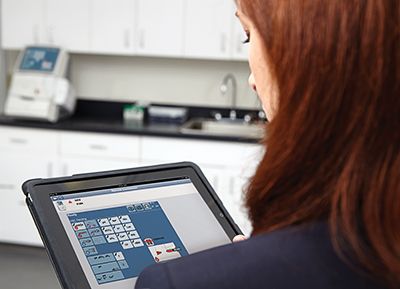New Siemens RAPIDComm System release delivers workflow innovation for point of care

The upgrade includes support for the new RAPIDComm Web Application enabling management of blood gas analyzers from an iPad, as well as an interface to PEP (Personalized Education Plan) Administrator, Siemens web-based learning management system.*
“Point-of-care customers are typically responsible for keeping hundreds of devices spread throughout a hospital up and running, as well managing the training and secure instrument access for thousands of operators — all while delivering fast, reliable results,” said David Stein, Ph.D., CEO of the Point of Care business unit in the Diagnostics division of Siemens Healthcare.
“With its new mobile access and functionality for centralized management of the operator recertification process, the upgraded RAPIDComm System helps our customers to better meet these challenges. This advances our ecosystem approach to managing POC testing.”
A POC Ecosystem approach takes into account the many interdependent components involved with hospital-based near-patient testing and focuses on improving the control, effectiveness and transparency of POC testing programs. The POC ecosystem consists of several core components, including device and operator management, quality control (QC), compliance reporting, competency management, inventory management, remote monitoring and mobile access.**
The latest version of the RAPIDComm System includes the RAPIDComm Web Application, which allows POC coordinators to quickly view the status of their POC instruments and troubleshoot issues from a handheld device. It even enables customers who manage blood gas analyzers to remotely view and control their instruments directly from an iPad, regardless of where they are located.
Another feature of the upgrade is an interface to PEP Administrator. This lets coordinators create and assign to instrument operators custom internet-based quizzes (e-quizzes), which must be successfully completed for training and certification. Further, the RAPIDComm System can then automatically recertify operators and centrally manage and download their IDs and passwords to the appropriate POC testing instruments, ensuring secure access. This feature can help POC coordinators reduce the manual steps involved with the operator certification process.
In addition, new Device Workload Reports help customers manage their consumable inventory by identifying the number of patient and quality control (QC) samples processed by their POC devices. Further, the new system helps record electronic reviews of patient and QC results and provides the ability to document instrument operator training and assessment information. This helps satisfy POC testing compliance requirements used by accrediting agencies such as the College of American Pathologists (CAP) and the Joint Commission on Accreditation of Healthcare Organization (JACHO).
For further information on the Siemens RAPIDComm Data Management System, please visit: www.siemens.com/rapidcomm
*PEP Administrator is not available for purchase in all countries. PEP Administrator is part of the company's Personalized Education Plan (PEP), the industry's first virtual, single source education solution for life-long learning.
**Gramz J, Koerte P, Stein D. Managing the Challenges in POC Testing: An Ecosystem Approach. Point of Care. The Journal of Near Patient Testing and Technology, 2013; 12(2): 76-79
The Siemens Healthcare Sector is one of the world's largest suppliers to the healthcare industry and a trendsetter in medical imaging, laboratory diagnostics, medical information technology and hearing aids. Siemens offers its customers products and solutions for the entire range of patient care from a single source – from prevention and early detection to diagnosis, and on to treatment and aftercare. By optimizing clinical workflows for the most common diseases, Siemens also makes healthcare faster, better and more cost-effective. Siemens Healthcare employs some 52,000 employees worldwide and operates around the world. In fiscal year 2013 (to September 30), the Sector posted revenue of 13.6 billion euros and profit of 2.0 billion euros. For further information please visit http://www.siemens.com/healthcare
The products/features (here mentioned) are not commercially available in all countries. Due to regulatory reasons their future availability cannot be guaranteed. Further details are available from the local Siemens organizations.
Reference Number: HDX201403020e
Contact
Media Contact
All latest news from the category: Medical Engineering
The development of medical equipment, products and technical procedures is characterized by high research and development costs in a variety of fields related to the study of human medicine.
innovations-report provides informative and stimulating reports and articles on topics ranging from imaging processes, cell and tissue techniques, optical techniques, implants, orthopedic aids, clinical and medical office equipment, dialysis systems and x-ray/radiation monitoring devices to endoscopy, ultrasound, surgical techniques, and dental materials.
Newest articles

Properties of new materials for microchips
… can now be measured well. Reseachers of Delft University of Technology demonstrated measuring performance properties of ultrathin silicon membranes. Making ever smaller and more powerful chips requires new ultrathin…

Floating solar’s potential
… to support sustainable development by addressing climate, water, and energy goals holistically. A new study published this week in Nature Energy raises the potential for floating solar photovoltaics (FPV)…

Skyrmions move at record speeds
… a step towards the computing of the future. An international research team led by scientists from the CNRS1 has discovered that the magnetic nanobubbles2 known as skyrmions can be…





















